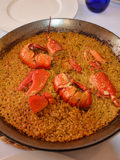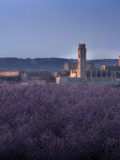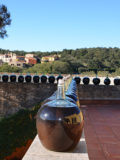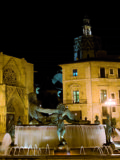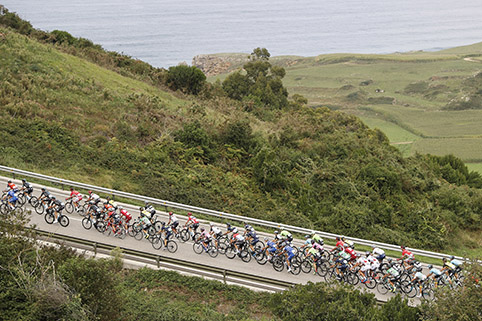
Vuelta España 2017;18ª Suances-Santo Toribio de Liebana 169 Km. Photo: ASO Unipublic, Gomez Sport, Luis Angel Gomez
By Carolyn Worthington
On to the Vuelta
As we saw every day, the region around Valencia is a perfect cycling country. From the seemingly ubiquitous well-marked bike paths in cities to the quiet country roads that led to the vineyard we visited, rolling countryside, and winding passes through the mountains, cyclists are everywhere.
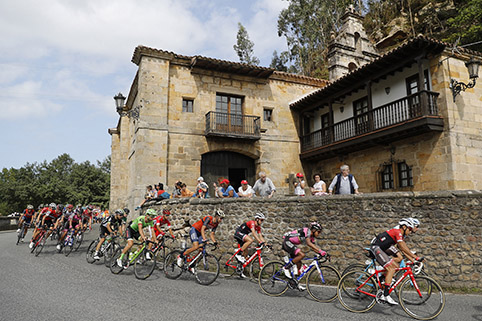
Vuelta España 2017;18ª Suances-Santo Toribio de Liebana 169 Km
So, as we left the wine country and headed north to the coast, my husband finally got his wish, a chance to witness Spain’s most famous cycling event—La Vuelta.
Of course, everyone has heard of the Tour de France. But how many know that “Le Tour” is just one of three, 21 day “Grand Tours” of cycling that take place every year? The Giro d’Italia in May and the Vuelta d’Espana in August and September bookend the Tour.
And they all feature the world’s top professional cyclists racing through each country’s amazing countryside. Not only are they the three most grueling endurance sports contests on the planet, but they can also lay realistic claim to being the backdrop for the most unique travel shows ever conceived.
The Vuelta is the youngest of the three, having a history dating back to 1935. This year, 198 of the world’s best pros in 22 teams raced for 21 days and 2,044 miles throughout Spain. Cities and regions throughout the country pay big euros to host a stage for its economic windfall and international recognition.
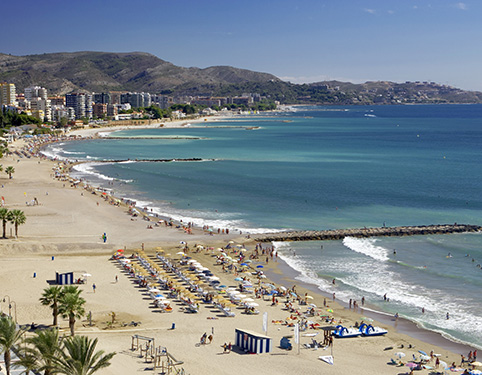
Benicassim Beach. Photo: Valencia Tourism
Benicassim – Beach Town and Start of La Vuelta Stage
Benicassim is a gorgeous beach town along the Costa del Azahar, which literally means Orange Blossom Coast.
Since the town is hugged by the Desert de les Palmes mountain range, the strong north winds are blocked. Hence, you do not see a lot of hotels with glass windscreens up everywhere like you do at some along the Mediterranean.
Of course, the best thing to do here is to spend a day at the beach on the clean white sand and in the warm sea with the gentle waves. But not for us! Tomorrow, on a hot day in August, Benicassim would play host to the start of stage five of the 21-day Vuelta a España, and we couldn’t miss it.
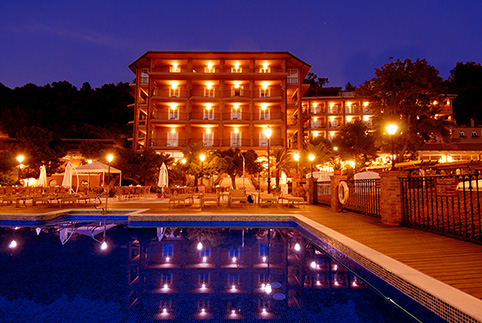
Thalasso Hotel El Palasiet. Photo: Thalasso Hotel El Palasiet
But first, our hotel…
At the north end of the broad Almadraba Beach sits the hillside spa of El Palasiet. Known for its indoor and outdoor salt-water pools, this 19th century classic villa is surrounded by magnificent gardens and great views of the beach that’s only 60 steps away.
Totally remodeled between 2002 and 2005, there is no better place from which to start and finish (or watch!) a leisurely or vigorous bike ride. We arrived in the late afternoon and, from the sea-facing balcony of our comfortable suite at El Palasiet, we saw a steady stream of cyclists from easy pedaling families to lycra-clad enthusiasts riding the bike path.
After a long day in the car, we opted for a couple of glasses of fine Valencia region wine and a leisurely early dinner by the poolside.
Benicassim for Cyclists and Walkers

Via Verde del Mar (Greenway of the Sea) bike path along the sea. Photo: Valencia Tourism
Cyclists and walkers love the Via Verde del Mar (Greenway of the Sea), which runs about 3.5 miles between Benicassim and Oropesa del Mar, another seaside town. This dedicated cycling-walking path along the beach is part of Spain’s rails-to-trails program, sponsored by the Foundation of the Spanish Railways. This particular path has a long illuminated tunnel to ride through, metal bridges to ride over, and amazing views. It is perfect for novice riders since it is very flat and smooth.
For those wanting longer rides, you can check out the cycling website Map My Ride, which lists over 69 great routes from Benicassim.
There are more than 4,700 miles of railroad beds in Spain that are no longer in use and are part of the program, started in 1993, that turns them into paths for cycling and walking. Over 1,600 miles have been converted today at the national level, led by the Greenways of Spain.
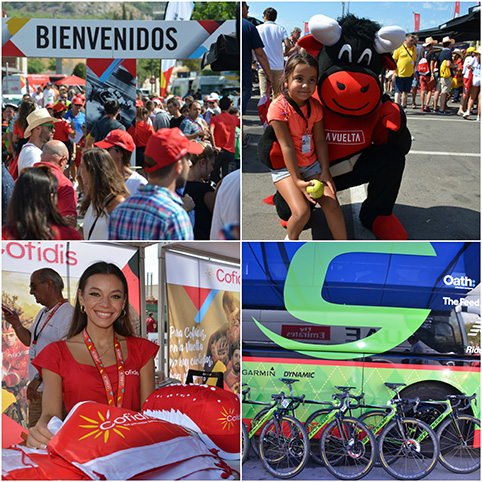
Scenes from the start line of La Vuelta, Benicassim. Photos: C. Worthington
Spending the Day Following the Race
We had passes to the pop-up start village in the center of Benicassim where all the pro teams, officials, and fans come together for the day’s start. Sponsor tents, stage performers, huge team buses, and even an official barber occupy race watchers for an hour or two before the whole entourage of official cars, motorcycles, and camera crews eventually pull out, surrounding the pack of lean racers.
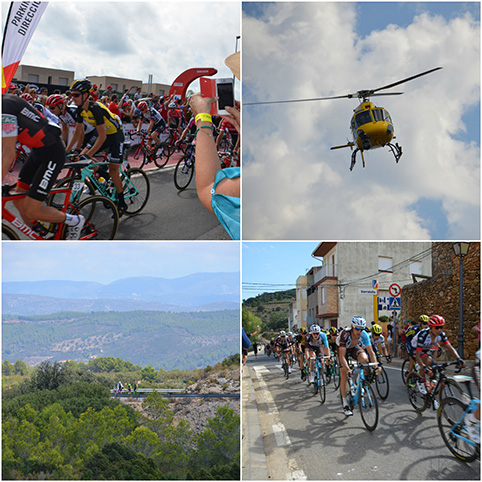
(Clockwise from top left) Riders leave the start. Helicopter signals the arrival of the riders at the hill climb. Riders race through small town at top of a climb. Amateurs try their fitness up the same race route climb. Photos: C. Worthington
It’s a loud, colorful scene as they pull away from the start to carnival music, blaring car horns, and the whump, whump, whump of television helicopters overhead.
To get the full flavor of this amazing event, we picked La Serratella, a small village just past the summit of the biggest hill climb, 78 miles into the 110 miles that would be covered in the day’s stage. We headed there by car, making sure that we were hours ahead of the race when we joined the race route into the mountains.
This is where the popularity of Spanish cycling is most obvious. On our way up the mountain, we passed hundreds of club cyclists who were pedaling to the top and also less active fans who were setting up awnings and picnic tables on the switchback turns.
La Serratella was an out-of-the-way, small mountain village with only one smoky café where all the cycling fans converged to wait for the riders. One big-screen TV projected the live action from the road below, and the café owners hustled to fill orders on what had to be their biggest day of the year.
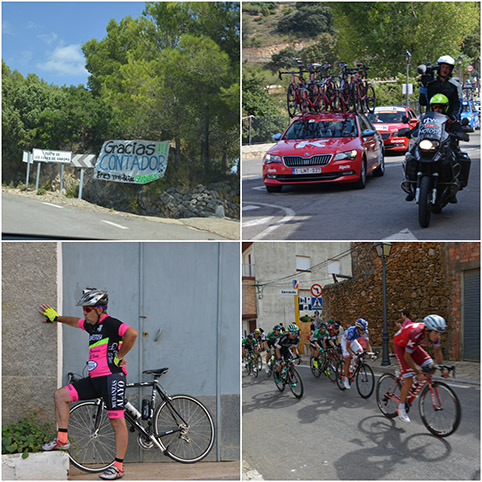
(Clockwise from top left) Spectator-designed sign thanking the famous Contador for his years as a winning cyclist. Caravan of team cars and camera bike pass through town. Cyclists race through town. Spectator watching the race and most likely will try his hand at the course after the race moves through. Photos: C. Worthington
Excitement built as word spread that the riders were coming. Suddenly, the uphill stretch of road through town was packed with people on both sides. Cheers erupted every time an official motorcycle or flashing car came through. Most of the drivers waved, but some, intent on their solemn missions, looked straight ahead.
And then, the first racers. A group of eight, riding impossibly fast up and through town, were met with hysterical cheering and finger pointing at one of the recognized stars. They disappeared without a backward look. The big pack came through five minutes later to even more cheering and finger pointing.
Then it was all over. Fans dispersed and the few who were left behind clapped for the stragglers. Traffic cones and caution tape were taken down, and most everyone there headed back down the mountain, leaving the villagers of La Serratella with something to talk about for years to come.
We talked about the race on the way back to Benicassim and the spa at Hotel El Palasiet. The riders would race on for another two hours today and finish up the coast in Alcossebre. They would race for another 17 days around Spain before finishing in Madrid over two weeks later.
A few hours in the spa sounded a lot better.



